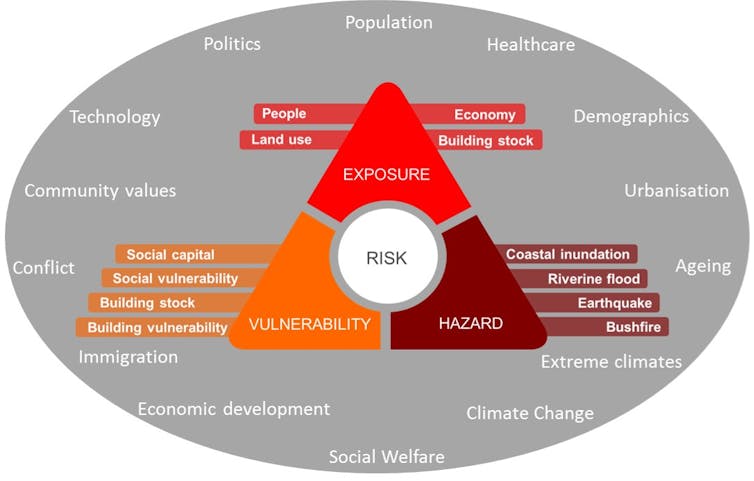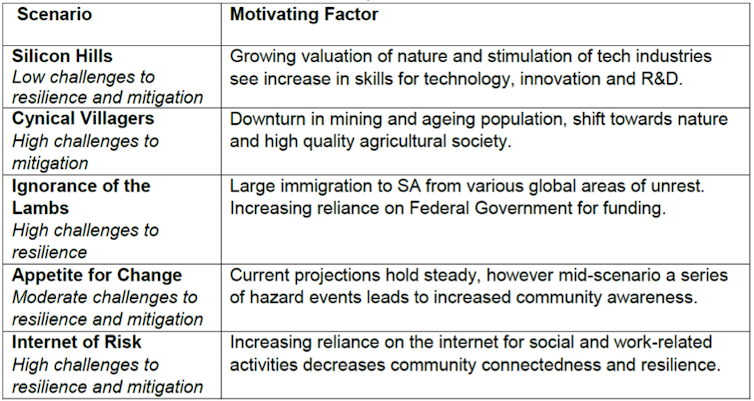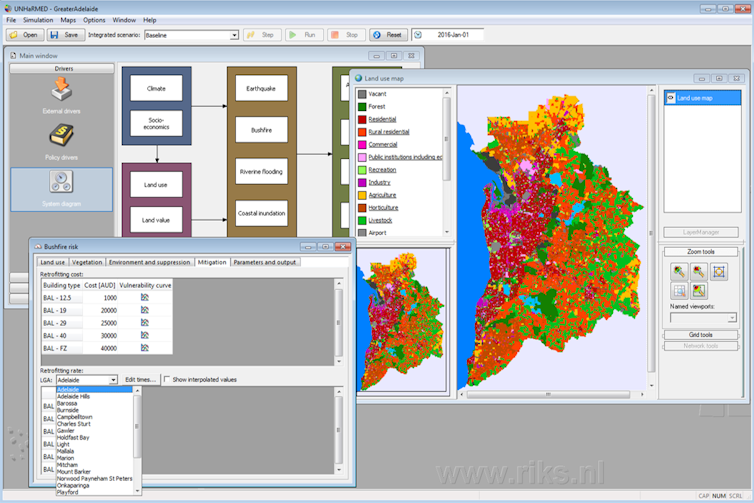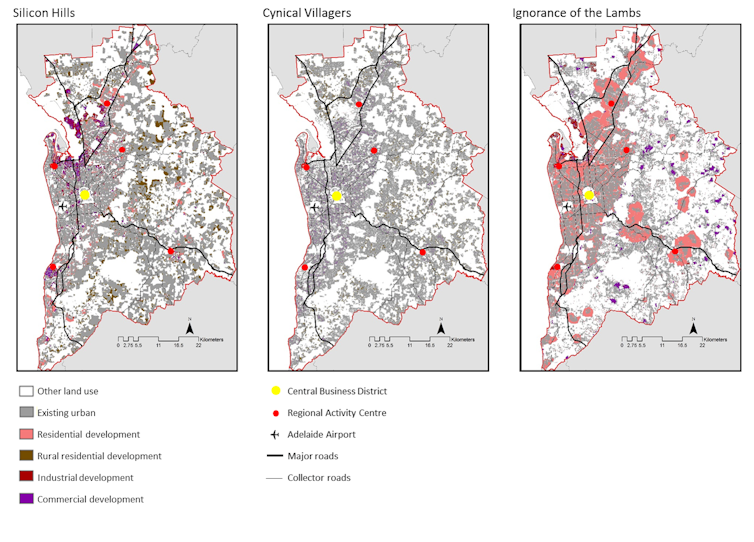Natural hazard risk: is it just going to get worse or can we do something about it?
- Written by Holger Robert Maier, Professor of Civil and Environmental Engineering, University of Adelaide
Tomorrow’s risk is being built today. We must therefore move away from risk assessments that show risk at a single point in the present and move instead towards risk assessments that can guide decision makers towards a resilient future. – Global Facility for Disaster Reduction and Recovery (2016)
But how can we do this? What decisions can we make today that will reduce the future risk of natural hazards, especially in a time of climate change? As an example, let’s take Adelaide, the South Australian capital, which is home to about 1.3 million people. We modelled five different plausible futures for greater Adelaide to explore the impacts of different risk-reduction strategies.
 Modelling different plausible futures for greater Adelaide is a way to explore the impacts of risk-reduction strategies.
Author provided
Modelling different plausible futures for greater Adelaide is a way to explore the impacts of risk-reduction strategies.
Author provided
When considering natural hazard risks, most people think about bushfires and floods. These risks are likely to get worse as a result of climate change. While we certainly need to act now to reduce climate change impacts, this is largely beyond the control of local governments.
But
In Adelaide, for instance, if we allow more people to live near rivers, they are more likely to be exposed to floods. And if more people live in the Adelaide Hills, they are more likely to be exposed to bushfires.
Further reading: Higher density in a flood zone? Here’s a way to do it and reduce the risks
Given the city’s population is expected to grow, land use planning is an essential aspect of hazard risk reduction. Planning should ensure that development occurs in areas where hazards are less likely to occur – if there are no people or buildings in areas prone to bushfires or floods, then there is no risk.
Local governments can also make decisions now that are likely to increase the resilience of communities and buildings that are exposed to hazards. For example, if building codes in Adelaide are changed today to require that all new buildings in bushfire-prone areas are built from non-combustible material, bushfire risk is unlikely to increase significantly. The risk might even decrease as old building stock is renewed.
Similarly, community education and campaigns to increase volunteering rates can increase long-term community resilience.
So the key to reducing risk is to understand that natural hazard risk is a combination of hazard, exposure and vulnerability (Figure 1).
Figure 1: Elements of natural hazard risk
 Author provided
The hazard component of the risk triangle in figure 1 corresponds to the likelihood that a hazard, such as a flood or bushfire, will actually occur at a particular location. If there is no hazard, there is no risk.
Exposure refers to who or what is exposed to the hazard at a particular location (who or what is getting wet, for example, in the case of a flood). This could be people, industry, agriculture, buildings and critical infrastructure. So even if a hazard occurs at a particular location, if nothing of value is exposed to the hazard, there is no risk.
Vulnerability corresponds to the impact or damage to people and assets that are exposed to a natural hazard event. For example, if a building is exposed to a bushfire, how the building is constructed has an impact on the resulting damage.
Further reading: Future bushfires will be worse: we need to adapt now
It is also vital to understand that long-term local planning decisions have greater potential to affect changes in exposure and vulnerability. This, then, is where we find the greatest opportunity for reducing long-term natural disaster risk.
Given that risk-reduction measures targeting exposure and vulnerability take time to take effect, it is vital that decisions affecting future risk are made now. A potential problem with this approach is that we don’t know what the future holds, especially in a time of unprecedented technological, political and socioeconomic change.
Modelling different scenarios
To manage this challenge, we worked with policymakers to develop storylines representing five different plausible futures for greater Adelaide until 2050. These scenarios were framed around challenges to community resilience and to implementing top-down policy measures to reduce natural hazard risks (Table 1).
Table 1: Challenges to implementing mitigation options and to community resilience
Author provided
The hazard component of the risk triangle in figure 1 corresponds to the likelihood that a hazard, such as a flood or bushfire, will actually occur at a particular location. If there is no hazard, there is no risk.
Exposure refers to who or what is exposed to the hazard at a particular location (who or what is getting wet, for example, in the case of a flood). This could be people, industry, agriculture, buildings and critical infrastructure. So even if a hazard occurs at a particular location, if nothing of value is exposed to the hazard, there is no risk.
Vulnerability corresponds to the impact or damage to people and assets that are exposed to a natural hazard event. For example, if a building is exposed to a bushfire, how the building is constructed has an impact on the resulting damage.
Further reading: Future bushfires will be worse: we need to adapt now
It is also vital to understand that long-term local planning decisions have greater potential to affect changes in exposure and vulnerability. This, then, is where we find the greatest opportunity for reducing long-term natural disaster risk.
Given that risk-reduction measures targeting exposure and vulnerability take time to take effect, it is vital that decisions affecting future risk are made now. A potential problem with this approach is that we don’t know what the future holds, especially in a time of unprecedented technological, political and socioeconomic change.
Modelling different scenarios
To manage this challenge, we worked with policymakers to develop storylines representing five different plausible futures for greater Adelaide until 2050. These scenarios were framed around challenges to community resilience and to implementing top-down policy measures to reduce natural hazard risks (Table 1).
Table 1: Challenges to implementing mitigation options and to community resilience
 Riddell et al, 2017, Author provided
We then modelled these scenarios in a decision-support system that integrates models for hazards, land use and building stock (Figure 2).
Figure 2: Integrating models for hazards, land use and building stock in a decision support system
Riddell et al, 2017, Author provided
We then modelled these scenarios in a decision-support system that integrates models for hazards, land use and building stock (Figure 2).
Figure 2: Integrating models for hazards, land use and building stock in a decision support system
 Author provided
Risk was expressed in terms of average annual loss per 100m by 100m grid cell. This enabled us to compare the risks associated with the different hazards in each mapped area (Figure 3). For the purposes of illustration, these three scenarios are shown:
Silicon Hills (low challenges to mitigation and resilience) - Greater Adelaide transitions towards a new technology-focused economy, driven by highly skilled and engaged locals and expatriates. Residents enjoy the relaxed, nature-filled lifestyle the region offers.
Cynical Villagers (mitigation challenges dominate) – Greater Adelaide experiences low population growth but maintains a preference for large, newly developed properties. Community attitudes lead to environmental assets being strongly protected with an emphasis on small-scale, high-quality agricultural products.
Ignorance of the Lambs (resilience challenges dominate) – Greater Adelaide experiences large population growth, driven by migration. This creates a need for more commuter developments, with people attracted to existing activity centres along transport routes.
Figure 3: Changes in exposure to hazards for three of the five scenarios
Author provided
Risk was expressed in terms of average annual loss per 100m by 100m grid cell. This enabled us to compare the risks associated with the different hazards in each mapped area (Figure 3). For the purposes of illustration, these three scenarios are shown:
Silicon Hills (low challenges to mitigation and resilience) - Greater Adelaide transitions towards a new technology-focused economy, driven by highly skilled and engaged locals and expatriates. Residents enjoy the relaxed, nature-filled lifestyle the region offers.
Cynical Villagers (mitigation challenges dominate) – Greater Adelaide experiences low population growth but maintains a preference for large, newly developed properties. Community attitudes lead to environmental assets being strongly protected with an emphasis on small-scale, high-quality agricultural products.
Ignorance of the Lambs (resilience challenges dominate) – Greater Adelaide experiences large population growth, driven by migration. This creates a need for more commuter developments, with people attracted to existing activity centres along transport routes.
Figure 3: Changes in exposure to hazards for three of the five scenarios
 Author provided
A ‘policy wind tunnel’ test
We could then explore the impacts of different risk-reduction strategies under a range of plausible climate, economic and population scenarios.
Using exploratory scenarios together with modelling to support decision-making enables us to explore the impact of today’s decisions on the potential future risk of natural hazards in a safe environment. It’s like using a “policy wind tunnel” to stress-test different risk-reduction strategies under a range of potential future conditions.
Such an approach enables decision-makers to minimise future risks by identifying and implementing policy options that are likely to be effective under a wide range of plausible conditions. And that means we can avoid being caught by surprise by the impacts of future natural hazard events.
Author provided
A ‘policy wind tunnel’ test
We could then explore the impacts of different risk-reduction strategies under a range of plausible climate, economic and population scenarios.
Using exploratory scenarios together with modelling to support decision-making enables us to explore the impact of today’s decisions on the potential future risk of natural hazards in a safe environment. It’s like using a “policy wind tunnel” to stress-test different risk-reduction strategies under a range of potential future conditions.
Such an approach enables decision-makers to minimise future risks by identifying and implementing policy options that are likely to be effective under a wide range of plausible conditions. And that means we can avoid being caught by surprise by the impacts of future natural hazard events.
Authors: Holger Robert Maier, Professor of Civil and Environmental Engineering, University of Adelaide





